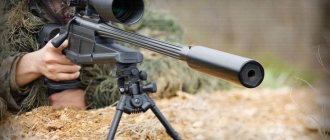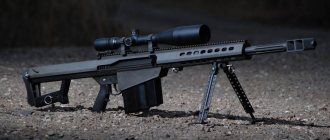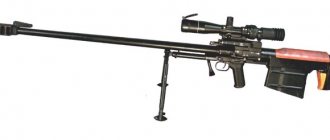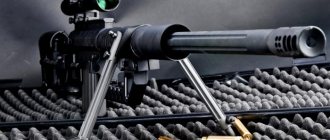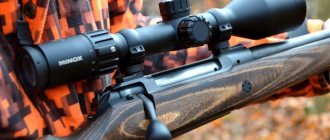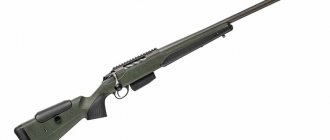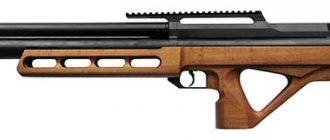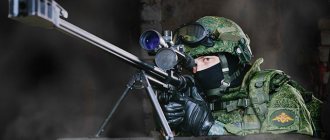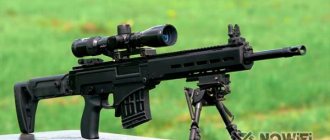From forests to landfills
The first .338 caliber (8.6 mm) cartridges were created in the 80s by order of the US Department of Defense for a new sniper rifle. Promising ammunition was supposed to have sufficient penetrating effect against manpower protection equipment at a distance of 1000 m. Then the developers were unable to achieve the required characteristics due to the use of a hunting cartridge in the design of the cartridge case.
Later, the Finnish company Lapua modified the cartridge case and in the late 80s released a sporting and hunting cartridge on the commercial market under the designation .338 Lapua Magnum. The 8.6×69 mm cartridge made it possible to fire rifles at a distance of up to 1500 m. Soon a number of well-known arms factories began to produce sniper rifles chambered for the new cartridge, and 8.6 mm weapons appeared among snipers in special forces units. The successful use of the new sniper system in the operations of the coalition of international forces in Afghanistan and Iraq contributed to the rapid spread of three-three-eight caliber rifles around the world. In November 2009, British sniper Craig Harrison, using an 8.6 mm L115A3 rifle, set a documented record for the distance to engage an enemy at a distance of 2475 m. This result remains a record in its class, later losing the palm only to the larger caliber 12.7 mm .
Sniper cartridges developed by TsNIITOCHMASH
The first Russian high-precision long-range cartridge was also born on the basis of hunting ammunition. The “donor” for it was the Soviet hunting cartridge 9.3x64 mm, intended for hunting large animals weighing up to 500 kg. In the 90s, when developing a new sniper cartridge, the Central Research Institute of Precision Engineering (TSNIITOCHMASH) again returned to its early “civilian” developments. Having followed the path of American developers, Russian engineers stepped on the same rake, when a smooth transition from “hunting the beast” to specific military tasks was doomed to failure. Nevertheless, TsNIITOCHMASH specialists brought their work to its logical conclusion, delivering the required product to the customer as part of the development work (R&D) “Vzlomshchik-9”.
History of creation
In 1987, snipers of special forces units received at their disposal the excellent VSS Vintorez sniper rifle. To this day, she is considered one of the best combat friends of the “ghost killers,” especially when it comes to performing missions where high mobility and, above all, the stealth of a fighter are required.
Soviet commanders understood that if a sniper used an SVD, then after firing a shot, even if not immediately, but from the second or third shot he would certainly reveal himself.
In a number of circumstances, such as when performing combat missions in urban environments, this meant that additional manpower had to be allocated to cover the sniper's retreat. Because, since such a specialty appeared, the enemy has not stood on ceremony with accurate snipers in any of the armed clashes of the twentieth century.
In some cases, the chase could last up to several days, and it was very difficult for a well-aimed shooter to escape from an angry enemy. It was impossible to neglect the life of a sniper, and the cover group reduced the chances of remaining unnoticed.
The VSS has made the task of many shooters much easier, effectively hitting targets at a distance of up to 400 meters with the subsonic 9 mm SP-5 cartridge. Vintorez was first used in 1990, when suppressing a riot of prisoners in a prison in the city of Sukhumi.
According to one of the participants in those events, fear was sown in the ranks of the rioters by the understanding that targeted fire was being fired at them, but they could not understand where they were shooting from.
But, despite all the excellent tactical and technical characteristics of this rifle, it remained quite expensive. And the Alpha and Vympel units, SOBR and special forces of the Ministry of Internal Affairs could afford to keep it in their arsenal.
The structural units of law enforcement agencies had to be content with a reliable, but already slowly starting to age, SVD. It is based on this fact that the Tula Instrument Design Bureau in 1992 begins to develop a military sniper complex, which will be cheaper to produce than the already famous VSS, but will not be inferior to it in terms of characteristics.
The developers of TsNIITochMash decided to take the 9A-91 assault rifle, which was being developed in parallel, as a basis. Engineers V. Kulitsky and V. Gryazev designed a model of the VSK-94 rifle, in which, instead of the folding butt of the automatic version, a hard plastic one was used, visually reminiscent of the same one as that of the Vintorez. A muffler (removable) and a mount for installing an optical sight were also added. The mechanical sight was adapted for the sniper, and with its help it was possible to easily fire at a distance of up to 400 meters, in the absence of the possibility of using optics.
"Burglar-9"
In March 1998, the Main Rocket and Artillery Directorate (GRAU) opened the Vzlomshchik-9 R&D project to develop a 9-mm sniper complex to replace the 7.62-mm complex with the SVD rifle, ensuring an increase in firing efficiency by 1.3-1.5 times . The requirements for the complex were repeatedly adjusted and clarified; in the final version, the probability of hitting a target wearing a 6B23 body armor with the first shot at 500 m was at least 80%.
The production of the 9-mm rifle cartridge was entrusted to the Novosibirsk Cartridge Plant, and the Izhevsk Machine-Building Plant (Izhmash) began manufacturing ballistic barrels. It was then that it became clear that new live cartridges could easily be used in hunting weapons. To meet the requirements of the Weapons Law, the rifling pitch for the sniper rifle was reduced from 365 to 295 mm. The Novosibirsk Central Design Bureau "Tochpribor", the Krasnogorsk Mechanical Plant and the Kazan Design Bureau "SCAN" were ordered to provide the complex with sighting devices.
Comparison of 9mm and 7.62mm sniper systems
In addition to the manufacture of ballistic barrels, Izhmash was developing a self-loading sniper rifle. Izhevsk also took the path of least resistance, taking the design of the well-known SVD as the basis for the future rifle. For the new rifle, a receiver, bolt frame and bolt similar to the SVD type were designed, but of increased dimensions, as well as a suspended barrel and a removable bipod. The rifle with the SN sniper cartridge received a 1.5-2 fold advantage in combat effectiveness over the standard SVD with the 7N14 cartridge. In addition, the 9-mm sniper cartridge ensured penetration of 10-mm armor plate at a range of 100 m.
To improve the accuracy of the rifle's fire, it was decided to first return to a rifling pitch of 365 mm, increasing their number to 6, and then return to 4 rifling again, but with a pitch length of 390 mm. Problems during testing arose not only with the rifle, but also with cartridges and optical instruments. Field tests of the 6B9 rifle were completed only in May 2003. The commission’s conclusion stated that “the 6S7 9-mm sniper complex does not fully satisfy the requirements of the technical specifications and, before being submitted for state testing, must be improved in terms of operational reliability and survivability of rifle parts and in cutting sights for the refined ballistics of the 7N33 cartridge.”
Rifle 6B9
From 2004 to 2005, state tests were carried out, for which two versions of sniper rifles with 4x390 mm and 6x365 mm rifling were presented. Based on the test results, 4x390 mm rifling, which showed slightly better accuracy, was recommended for further testing, and the 9-mm 6S7 sniper complex, which met the requirements of the GRAU technical specifications, was recommended for adoption.
The 6V9 rifle, 7N33 cartridge, 1P70 and 1PN101 sights were adopted into service by the Russian army only in 2013. However, by this time, foreign and Russian rifles chambered for the standard .338LM cartridge had already appeared in some law enforcement agencies, which were significantly superior to domestic developments in long-range shooting accuracy. As a result, the long-term struggle for the “three-three-eight” cartridge was lost, and the Russian Ministry of Defense did not introduce the 6S7 complex into the armed forces.
Opponents and weapons in the game
Weapon Knife is a melee weapon available from the very beginning of the game. Throwing knife is a throwing melee weapon that quickly and silently kills an enemy upon impact and can be reused. Appears after meeting with Bourbon, sold in all stores. You can carry no more than 5 knives. The revolver is the main and most common weapon; the player has it from the very beginning of the game. There is a version with an extended barrel that has more power. Revolver with a silencer - found in stores or in the mission "Front Line", has less power, but allows you to shoot silently and relatively unnoticed. * Revolver with stock - a long-barreled revolver equipped with a stock, which has greater accuracy. There is an option with optics and a silencer. “Bastard” is a low-power homemade machine gun, given to Artyom in the armory at VDNKh. It has a long reload time and low power, 30 rounds in the magazine, there is also a version with a silencer. AK74 is a more convenient assault rifle, has fast reloading and average power, 30 rounds in the magazine. Has an option with a 1.5x optical sight. VSV is a powerful silent machine gun with a laser sight, the magazine is designed to hold 20 rounds. There is a version with good optics. “Kalash 2012” is the most convenient assault rifle, has a laser sight, a magazine for 40 rounds, and reloads quickly. There is an option with optics, available in armories. The sawn-off shotgun is a medium-power homemade double-barreled shotgun that requires constant reloading. "Tikhar" is an air rifle that requires pumping up the cylinders to increase shooting efficiency. There is a version with optics. When firing, the power and firing range drops, so you need to constantly pump up the cylinder. “Uboynik” is a 6-shot semi-automatic shotgun, has a good rate and power of fire, and reloads slowly. Found in the “Sukharevskaya” chapter or in stores, it is reloaded using the revolver principle - cartridges are sorted into six compartments-slots; It is possible to load only up to 5 rounds from an empty clip. Also has a bayonet variant, with more power and damage. The Helsing Needle Thrower is a multi-barreled air gun that fires steel, unfeathered arrows that can be reused by picking them up from the point of impact. Found in the chapters “Front Line” and “Black Station”; a version with optics is sold on Kuznetsky Most. Automatic shotgun - found in the chapters “Kuznetsky Bridge” and “To Sparta”, a powerful automatic shotgun similar to a machine gun, requiring a long reload of 20 rounds, but having the highest rate of fire. Appears after installing the Ranger Pack. The electric gun or “Rail” is a handicraft gun found in the chapters “Kuznetsky Bridge” and “To Sparta”. Shoots pneumatic balls with an electric charge that kills medium enemies in one shot, but consumes energy. Has an electrified blow with the butt, which also consumes the charge. Appears after installing the Ranger Pack. Dynamite is an explosive in the form of a stick of dynamite made from a piece of pipe. Used as a grenade. Dynamite Hedgehog is an improved stick of dynamite with nails sticking out. Has the ability to cling to a wall or to an enemy, causing more damage due to flying nails. Opponents Ghouls are one of the very first monsters encountered in the game (after the prologue). They resemble pigs and can make powerful jumps over long distances. Kikimoras are fast and dexterous monsters that live in holes. The Guardian and the mutants living on the surface look like kikimoras covered with dark gray fur. Librarians live in the State Library named after. Lenin. They cannot stand noise and immediately attack when they see your back. If you look them straight in the eyes, trying not to come closer, you can most likely avoid aggression. Killing, in the presence of Helsing, is not particularly difficult. Three or four hits to the head and the mutant is dead. Demons are winged monsters that live only on the surface. Lianas are living plants hanging from the ceiling that hit quite hard, but are subdued by hitting the thickening on the ceiling with a revolver. Found in the library. Ghosts are creatures encountered upon entering D-6. Invisible unless you point a flashlight at them.
Amoebas - explode on contact and cause serious damage, found underground in chapter "D-6"
Proboscis are Ghoul-like creatures that live underground in D-6. Female ghouls are winged creatures that do not engage in melee combat. They emit a characteristic ultrasound that stuns the player.
Klimovskaya special
In 1998-1999, even before the start of the "Vzlomshchik-9" R&D project, TsNIITOCHMASH, commissioned by the FSB, began developing a 9-mm sniper complex within the framework of the "Aviary" R&D project, designed to destroy manpower and unarmored vehicles at a range of 1000 m. Initially, the SP cartridge The .14 for the SR.4 rifle was an almost complete copy of the Western 8.6x69 mm cartridge, with the exception of the Russian 7N33 cartridge bullet. Subsequently, to improve the accuracy of fire, the bullet of the SP.14 cartridge received a combined core of aluminum in the nose and lead in the tail, a modified cartridge case and special gunpowder. The dispersion diameter of such a target cartridge when fired from an SR.4 rifle at a distance of 300 m does not exceed 9 cm. The SP.14 cartridge and the SR.4 rifle were adopted by the FSB in 2011 and were manufactured at TsNIITOCHMASH.
The SR.4 rifle is a manually reloading weapon with the barrel bore locked by turning the longitudinally sliding bolt. The striker-type trigger mechanism has a safety catch against accidental firing and is designed as a separate unit for ease of maintenance. On the upper surface of the receiver there is a Picatinny rail for mounting optical instruments, as well as mechanical sights. The cartridges are fed from a five-place box magazine. The rifle butt is adjustable in length and height. The design of the SR.4 provides for replacement of barrels to increase the service life of the rifle.
Rifle SR.4
In 2013-2015, within the framework of R&D “Tochka-338” and “Accuracy-8.6”, in the interests of the Federal Security Service and the Ministry of Internal Affairs of the Russian Federation, the development of cartridges for federal agencies (VFD) was carried out. First of all, these works were an adaptation of the production of .338LM cartridges at Russian enterprises. In addition to the standard sniper cartridge with the PS bullet, TsNIITOCHMASH also developed a cartridge with the BP armor-piercing bullet. The new high-precision rifle was developed at Promtekhnologiya LLC (Orsis trademark) by slightly modifying the successful T-5000 sporting rifle. As a result, security forces received a new all-day high-precision sniper complex 8.6×69VSK with a VFO-8.6×69 rifle, 8.6 PFO PS and BP cartridges, a POFO optical sight, a DLFO laser rangefinder, a NNFO night attachment and a NTFO thermal imaging attachment.
Rifle VFO-8.6×69
At the end of 2022, the full cycle of cartridge production was established at the Ulyanovsk Cartridge Plant, and at the Tula Cartridge Plant the production of Volga Federal District cartridges is underway. The Kazan Research Institute of Chemical Products managed to achieve stable performance of Russian gunpowder for high-precision cartridges.
Top 5 newest Russian sniper rifles
The VII Moscow Security Conference was recently held. One of the items on the agenda of this representative forum was the demonstration of new developments in the field of modern weapons. This time the attention of the participants was drawn, among other things, to the variety of sniper rifles produced in Russia. The weekly Zvezda presents the best samples developed by designers of our military-industrial complex.
© sniper-weapon.ru VSV-338
VSV-338 - a killer new product from Kalashnikov
A high-precision sniper rifle chambered for .338 Lapua Magnum, abbreviated as VSV-338, developed by the Kalashnikov concern. This is an example of a weapon of modular design; all elements are “hung” on a supporting aluminum body. This arrangement allows you to quickly change the elements of the weapon, including the barrel, which is very important for high-precision weapons, in which any error will inevitably affect the shooting accuracy.
The declared firing range is 1,500 meters. The handguard of the VSV-338 has Key-MOD type grooves for attaching a bipod, a sling swivel and removable Picatinny rails for installing additional equipment. In the upper part of the body and forend there is a guide for installing an optical and mechanical sight, as well as a night vision device. The rifle is equipped with a folding stock with a cheek rest and shoulder rest that can be adjusted in height and in the side, as well as an additional retractable stand that can be adjusted in height. All controls are made of high-strength plastic and are symmetrically located on both sides of the weapon.
© lobaevarms.ru
SVLK-14S
SVLK-14S - long-range guard
The famous “sniper” SVLK-14S was produced by the Design Bureau of Integrated Systems (KBIS). It was designed specifically for ultra-long range shooting. Each element of the weapon is adapted to severe overloads and precisely adjusted. The mechanisms are made of high-alloy steel with elements made of aircraft-grade aluminum. A LOBAEV Hummer Barrels stainless steel match barrel is installed. The multi-layer stock is made of carbon fiber, Kevlar and fiberglass. The rifle is entirely made from domestic raw materials. In 2015, a modification SVLK-14M was developed. The main difference is the 5-round magazine.
The firing range declared by the manufacturer is 2,300 meters, but it was from this rifle that a record-breaking accurate shot was fired at 4,210 meters. From open sources it is known that SVLK is used in the Federal Security Service of Russia and in the special forces of the United Arab Emirates.
Chief designer Vladislav Lobaev speaks of his brainchild not without pride: “If my rifle shoots in competitions, then the others fight for second place. When special forces in the army or in another structure are armed with such a rifle, then I will know that my developments are being used successfully. In the future, we will develop systems that will shoot at 3 and 5 thousand meters. These distances are not for records, but for a sniper’s confident work within specific dimensions.”
© sniper-weapon.ru
Microwave
Microwave is a worthy successor to SVD
The Chukavina sniper rifle is another recent development of the Kalashnikov concern. The microwave is based on an experimental small-sized automatic machine (MA) by Evgeniy Dragunov, the creator of the famous SVD.
The new rifle is assembled according to a hinged, or curtain, design. All elements of the weapon are mounted on a durable upper rail. This means that all parts can be made from lighter materials, which means the overall weight of the weapon is reduced. With all this, the principle of operation of the automation is taken from the proven Dragunov sniper rifle - SVD. The microwave is designed for three calibers of cartridges - 7.62x51, 7.62x54 and .338 LM.
Professional athletes have already highly praised the microwave, noting its excellent ergonomics, soft feedback and versatility. The country's law enforcement agencies are also looking at the rifle. This weapon is for both long-range and melee combat.
© sniper-weapon.ru
VSSM
VSSM - silent killer
The Vintorez rifle is known to every serviceman in our army, and even to just a weapon lover. Excellent characteristics and memorable appearance made this sniper weapon popular both among special forces soldiers and among “forum warriors.” But not everyone knows that in 2015, a new modification of the silent rifle was put into service - the modernized special sniper rifle (VSSM).
Improvements and additions were made under the motto “Don’t break what isn’t broken,” that is, the very familiar principle of operation of this magnificent rifle has not been changed. VSSM is adapted to the most modern requirements for small arms. It has a new skeleton stock with cheek rest, Picatinny rails, new magazine and bipod. The barrel and muffler were also strengthened, their service life doubled.
"Deadly" soldiers
Since World War I, snipers have become the deadliest soldiers on the battlefield. During the Great Patriotic War, the most effective were Soviet snipers. The most famous Soviet shooter Vasily Zaitsev, together with his group, destroyed 1,126 fascist soldiers. Mikhail Surkov chalked up 702 enemy kills, Vladimir Salbiev - 601, Ivan Sidorenko - 500. Female sniper Lyudmila Pavlichenko destroyed 309 enemy soldiers and officers in fierce battles.
© orsis.com
ORSIS T-5000 M
ORSIS T-5000 M - a weapon for the sniper elite
A high-precision sniper rifle designed for both hunting and combat. The unusual name ORSIS, which involuntarily makes one think of the ancient Egyptian god Osiris, is in fact a Latinization of the abbreviation of the name.
This is a bolt action repeating rifle. The entire structure is made of high quality steel. The barrel is made on a CNC machine using a single-pass cutting method. This is by far the most advanced method of making barrels. The internal parts of the rifle are made of steel grades intended for the manufacture of surgical scalpels.
The rifle is perfectly balanced. When fired, the recoil goes straight back, without disrupting the aim. The T-5000 M was tested as part of the latest Russian combat equipment for military personnel, “Ratnik”.
This rifle is intended for the sniper elite, “piece” specialists in ultra-long-range shooting, the cost of training many times higher than the price of the most expensive shooting complex.
Tactical and technical characteristics of silent rifles
| Weapon | VSK-94 | VSS |
| Year of adoption | 1994 | 1987 |
| Caliber | 9*39 | 9*39 mm |
| Weight | 3.5 kg | 3.7 kg. |
| Length | 932 mm | 894 mm. |
| Rate of fire | 700 rounds per minute | 800 rounds per minute |
| Shop | 10 and 20 rounds | 10 and 20 rounds |
| Sighting range | 400 meters | 400 meters |
| Effective range | 300 meters | 250-300 meters |
| Barrel resource | 6000 shots | 5000 shots |
As we can see, the characteristics of both rifles are generally identical, except that in automatic mode the Vintorez shoots a little faster and is a little shorter than the VSK-94. But the VSK-94 requires a later barrel replacement than the VSS, without losing the quality of aimed fire.
In service
The military sniper complex was appreciated by precision shooting specialists from the first days of combat use. It took place during the conduct of hostilities during the first Chechen campaign. A group of militants was successfully eliminated by targeted fire from a pair of federal forces snipers from the VSK-94 during one of the clashes in the spring of 1996.
Currently, the VSK-94 is in service with the Russian Guard and the special forces of the Ministry of Internal Affairs. Also, a number of copies were purchased for their special operations forces by the armies of Mongolia, Belarus and Syria.
Since the adoption of the military sniper complex, it has undergone few changes and all of them were aimed at adapting mounts for sighting devices. Experimental versions of the VSK-94 were created for 7.62*39 mm, 5.45* 39 mm and NATO 5.56*45 mm cartridges, but these versions were not mass-produced.
VSK-94 first appeared in the computer duology “Alpha Anti-Terror” and “Alpha Anti-Terror: A Man’s Work” released in 2003 and 2004.
VSK-94 can be found in toys for those who like to survive in the vastness of the Stalker universe. In newer games, the military sniper complex can be found in the Survarium series.
